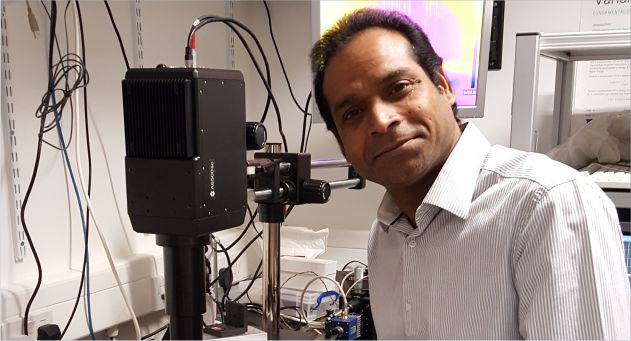ELE Times : Kindly tell us something about the recent development, applications and challenges you are seeing in biomedical innovations with photonic circuits?
Dr. Senthil Ganapathy : Photonic circuits have been used to manipulate, identify and quantify biological materials and cells and are also recently used to perform microscopy on chip with improved resolution leading to the observation many new cellular processes in-vivo.
Most recently on-chip microflow cytometers have been demonstrated using photonic circuits. The challenges are mainly in the labelling process i.e. surface functionalisation for specificity and non-specific binding is often a problem. However, techniques such as Mid-IR spectroscopy on chip will enable label free biomedical diagnosis without any need for surface functionalisation. This is still in its infancy but it has got huge potential in identifying the disease markers at the early stage of a symptom.
ELE Times : How novel materials are different from the other materials used in optical telecommunication? Give brief description on its advantages.
Dr. Senthil Ganapathy : The work horse for optical telecommunication so far is silica glass and starting from Charles Kao’s (Nobel laurate 2009) proposition to use optical fibre for telecommunication, silica has been purified to the best possible extent and it is now produced with incredibly low loss of about 0.148 dB/km and this is almost at its theoretical minimum. Other materials such as fluorides and chalcogenides have the potential to achieve much lower losses (1 – 2 orders of magnitude) than silica but unfortunately currently the losses observed in these novel materials are quite high mainly due to the impurities. Once these materials are purified to the extent Silica has been purified and also shifting the telecommunication window to longer wavelengths from the current 1.55um band to further reduce the losses due to Rayleigh scattering will make significant advancement in the transmission capability in telecommunication.
ELE Times : Tell us about your recent interest on “Novel Optical Microresonators”, its area of application and challenges you came across?
Dr. Senthil Ganapathy : Optical microresonators are building blocks in planar light wave circuits and they can perform optical functions such as filtering, logics, lasing, switching, delay and pulse shaping. They are also useful in sensing including single molecule detection. We have recently demonstrated many novel forms of optical microresonators (microdiscus, microbottle, hollowbottle and microstub) with very high quality factors. One such microresonator, microbottle resonator, has been demonstrated for true four-port add-drop filter application in telecommunication. Recently my interest is to use these microresonators for sensing applications and currently I am networking with IIT Madras and IIT Kharagpur in India to devise sensors based on these novel microresonators to monitor the water quality for various contamination and air pollution including trace toxic gas detection. The challenges are in packaging them as a compact and portable device to perform sensing at remote locations but we are looking in to various possibilities.
ELE Times : Talking about “Photonic Doping”, how it’s different from electronic doping and what is it used for?
Dr. Senthil Ganapathy : Electronic doping was mainly useful for altering the electrical resistivity of a material for example to produce n- and p-type semiconductors whereas doping a photonic material uniformly with impurities will give them the ability to generate new wavelengths and this is the basis of lasers and optical amplifiers.
Photonic doping also means adding a foreign material to a structured host material (metamaterial) to observe various optical phenomena that are not present in naturally existing materials such as negative refractive index and cloaking.

